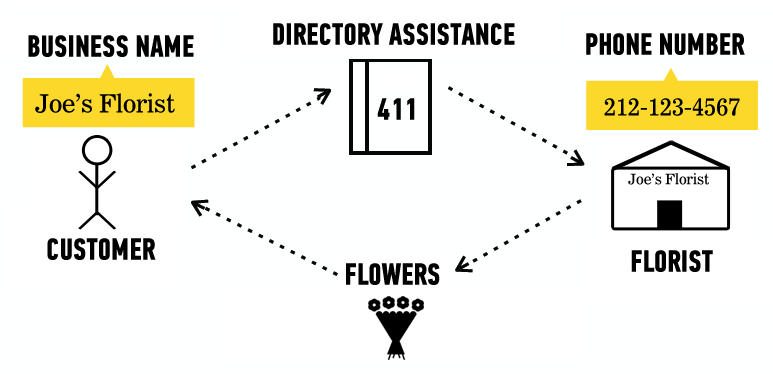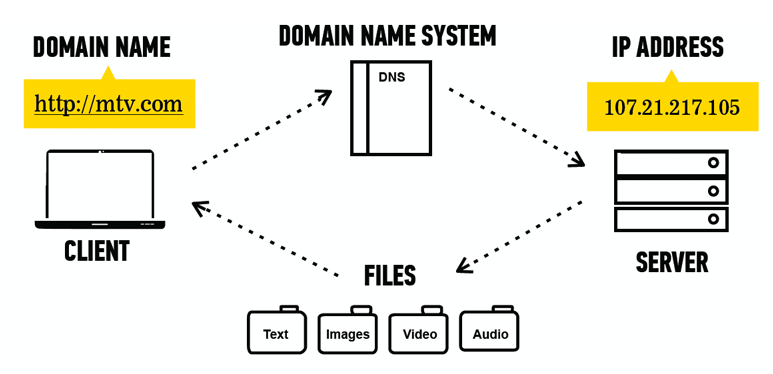Intro to Web Development With Python
Learning Objectives#
After this lesson, you will be able to:
- Describe how the web works.
- Explain what we mean by front-end and back-end.
- List the types of web developers.
Discussion: What's the Web?#
How do you think the web works?
Before we go about making a web app, let's start with how the web works at all.
Finding a Florist#
- How does a browser know what page to display?
Also known as:
- How do I call my florist? I can just call "Joe's Florist" in my phone contacts.

Talking Point:
- Joe's Florist is just the name of the contact. It's not the actual address or phone number. It exists and we can find it, but we have to look it up.
IP Addresses#
Website URLs — "Joe's Florist"
- Just names to make our lives easier.
https://google.comhttps://reddit.com
IP addresses — "515-115-5156"
- The actual address to which your browser goes.
Google.comis at172.217.12.142.reddit.comis at151.101.129.140.
Talking Point:
- The same way, Google.com is just the name of it. It's not the actual address on the internet. It exists and is reachable, but we have to look it up.
Client-Server Relationship Review#

Talking Points:
- Computers communicate with one another through the client-server model. The browser (aka, the client) makes a request to the server to view a website, and the server responds by sending the corresponding files back to the client.
- Our computers make an ask of the server, and the server sends back a response. We are going to learn how to make those "asks" with Python and HTML and also how to write programs that guide the "responses" with Python.
In Real Terms#
- Websites are just files your browser can read.

Talking Points:
- Websites are just files your browser can read!
- Different kinds of files can be retrieved from the server, including HTML and CSS files, which the client then reads and renders as a website.
What Types of Files?#
HTML (.html)
- Provides website structure.
CSS (.css)
- Adds colors and fonts.
JavaScript (.js)
- Makes the website interactive.
Images, text files, etc.
- Displays additional info on the webpage.
Talking Point:
- Note that we're going to learn HTML and CSS — don't spend a lot of time here!
Quick Review#
Where do websites exist?
- IP address: The actual location of a website on the internet.
Google.comis a friendly name for the IP address172.217.12.142, just like "Joe's Florist" is a friendly name for the phone number "(515) 115-5156."
How does a website work?
- Websites are actually just a bunch of files — images, text, and website-specific code.
- They're hosted on servers — all the files for Google.com live on Google's servers.
- Your browser is the client: It asks Google for the Google.com files so it can show them to you.
Discussion: What Is Web Development?#
Does anyone want to guess (or know) what web development comprises?
Talking Point:
- Encourage discussion!
Web#
The work involved with building and maintaining a live website is split into two sides:
Front-End
- In a restaurant:
- The dining room.
- In web development:
- What the user sees.
Back-End
- In a restaurant:
- The kitchen, loading dock, and offices.
- In web development:
- What makes the website work (e.g., connects to servers).
- Behind-the-scenes code.
Talking Points:
- Web development is using programming to build websites that render in a user's browser.
- A website is a collection of code that can be categorized into two types: front-end and back-end.
Front-End vs. Back-End: A Visual#

Talking Point:
- Note that front-end development is also programming, but back-end developers usually don't see the website.
Front-End vs. Back-End: A Better Visual#

Talking Points:
- The back-end is seen as much scarier, as it's more programming intensive.
- It's where we work out all the bugs!
We Do: Front-End vs. Back-End#
Head to the New York Public Library's website: https://www.nypl.org/.
- What is the happening on the front-end?
- What is happening on the back-end?
Types of Web Developers#
Front-End Developer
- Languages used: HTML/CSS/JavaScript.
- Works on what the user sees.
Back-End Developer
- Languages used: Python, PHP, Ruby, or many others.
- Works on making the website work.
Full-Stack Developer
- Does both as well as database work!
Quick Recap#
Front-end development:
- The visuals.
- How a website looks and how a user interacts with it.
Back-end development:
- The underlying code.
- How the website actually works.
Full-stack development:
- Includes both!
Discussion: What Is a Web Framework?#
Does anyone want to guess (or know) what defines a web framework?
Talking Point:
- Encourage discussion!
Web Framework#
Web frameworks are used by both front- and back-end developers to make it easier to develop a website or web app.
Programming libraries:
- Are free for your use.
They make development far easier because they:
- Provide the client-server relationship piece.
- Add features to make it easier to write a large web app.
Frameworks are usually language-specific. Popular examples include:
- Flask, Django, React.js, Angular.js
Discussion: Web App vs. Website#
Does anyone want to guess (or know) the difference?
Web App vs. Website#
A website:
- Is typically informational.
- Has little-to-no interactive capabilities.
- e.g., The New York Times or a small company's website.
A web app:
- Is an app hosted on the internet.
- Uses the client-server relationship to render a website.
- Offers the user more features than a static website.
- E.g., a bank's webpage or an auction site.
You can have a hybrid!
- For example, a website can be static until the user logs in.
- Then, it's a full-fledged web app.
Teaching Tip:
- Be clear about the terms "web app," "website," and "webpage."
Talking Points:
Note: This was taken liberally from https://modeeffect.com/key-differences-between-website-web-app/.
Websites are typically informational in nature. Think about your favorite blog or news-based site. Its primary purpose is to convey information to the end user, whether it in the form of news, like CNN, or recipes, like you’ll find on Martha Stewart.
As a general rule, there is little-to-no interaction on the part of the visitor, other than possibly submitting an email address to receive a monthly newsletter or performing a search. So the real question is, how does this apply to you?
Well, if you’re a local charity that wants to convey information only — e.g., a home page, an About page, contact information, upcoming events, and maybe a description of how you’ve helped your cause — then a website might be all you need.
You also need to consider that many websites are actually website/web application hybrids. Your startup might provide all kinds of information to visitors, but once they register they could have access to an integrated web application that performs a specific function.
Web Development Is Hard#
- Don't worry!
- GA has several classes dedicated to it (e.g., part-time Front-End Web Development or JavaScript Development, or the full-time Web Development Immersive).
- There's a lot of information out there!
Right now, we're going to be building web apps with Python!
Summary#
What did we do?
- DNS
- The actual address of a website.
- The Client-Server Relationship
- Server sends website files to the client (your browser).
- Front-End vs. Back-End
- What the user sees versus what makes the website work.